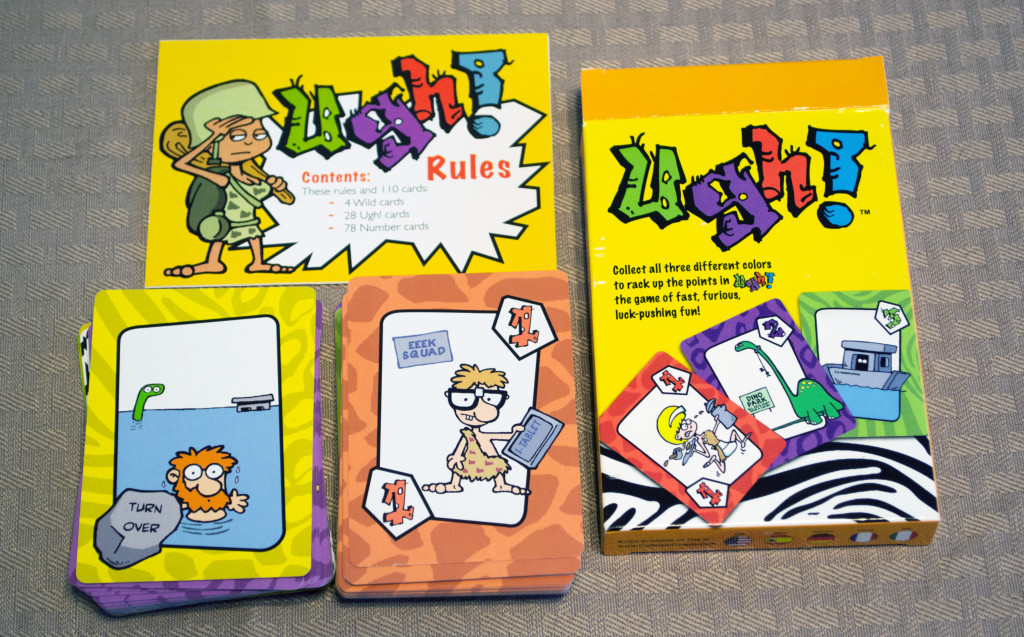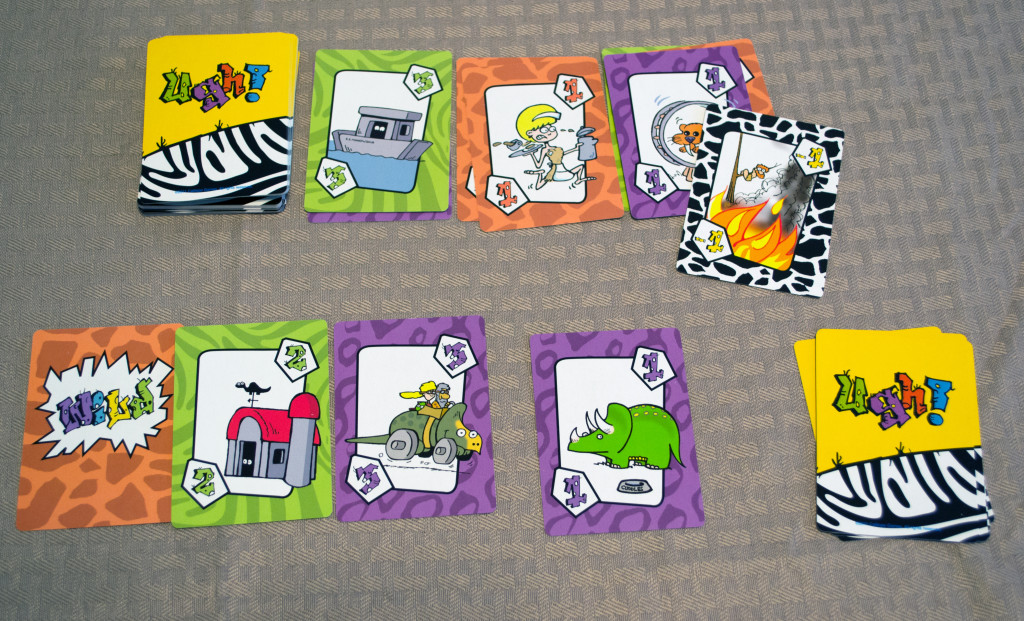“Ugh!”, as best as I can describe it, is a press-you-luck set-making game with a caveman theme…I’ll give you a few seconds to process that. It’s not as complicated as it sounds, though it does offer players some interesting choices. Before we get into all of that though, I’d like to thank both Ray Wehrs and Cassidy Werner from Calliope Games for providing me with a free press copy. If the names sound familiar, it’s because Calliope Games are the same folks who brought you “Tsuro“, “Tsuro of the Seas“, “Roll For It!“, and the more recent “Got ‘Em!“.
Components
Cards – The game comes with 110 cards that consist of a number of different types. The most common are your number cards which range from one through five and are one of three different colors (green, orange, or purple). There are some wild cards mixed in as well, which can either be one of the three aforementioned colors or all three…essentially, they can be any number of their color. Finally, you’ve got Ugh! cards that can do some pretty nasty things to the player who draw them.
Setup & Gameplay
The entire deck is shuffled and placed in the center of the table. That’s it. Seriously…that’s it. I should probably point out that you’ll want to leave room for imaginary piles to the left and right of the deck. The imaginary pile on the left is your discard pile while the THREE on the right are your safety piles…more on that in a minute. Each player should also reserve an imaginary score pile space near them as they’ll be accumulating sets throughout the game for endgame scoring purposes, as well as a space for cards they’ve taken but haven’t used yet to create said sets. The youngest player goes first.
On a player’s turn, they’ll draw a card from the deck and place it on the first safety pile space (closest to the deck). At this point, the player can opt to take a card from ANY of the three safety piles and place it in front of them or draw again. If they opt to do the latter, they’ll place the new card in the second safety pile space. Again, they can either opt to take a card from ANY of the three safety piles or draw again. Drawing a third time results in the card being placed in the third and last safety pile. If the player doesn’t take a card from one of three safety piles, they must draw a fourth time and keep it. If you happen to draw an Ugh! card, it’s possible that you’ll end up with nothing and even lose some of the cards you’ve accumulated and haven’t scored yet. Wild cards can be taken in this manner as well, though they can be discarded as they are drawn in order to steal another player’s number card (or all wild card) of the same color.
During a player’s turn, they can lock in sets. Sets consist of three cards, one of each color, taken from the cards you’ve accumulated in front of you. Scoring happens at the game’s end, but their point value is equal to their values multiplied together. Since the end result will be the same, it doesn’t matter in which order you multiply the three numbers (2x3x4 = 24, 2x4x3 = 24, 4x3x2 = 24, etc.). When creating a set, it’s important that you place these off to the side and separate them if at all possible. You could opt to put one set vertically and then the next on top of it horizontally for example, switching off as appropriate. You could place them into one giant pile so as long as you count by threes in order at the end of the game when calculating each set’s worth. Keeping score as you go rather than add them up at the end of the game is another viable alternative.
Ugh! cards do a number of different things like force players to discard cards in their pool (that they haven’t scored yet). If the first card a player draws on their turn is an Ugh! card, they will follow the instructions but place it into their score pile (it’s worth three points). If an Ugh card is drawn any other time, the directions are followed and the card is placed into the discard pile (to represent the player failing when pressing their luck). Ugh! cards end the current player’s turn and they’ll be unable to create sets after drawing one.
Once a player has ended their turn, the next player clockwise will take their turn. The game continues until there is only one card left to draw. When this happens, each player has an opportunity to lock in any sets they’d like. Once the final card is drawn and the turn resolved, the game ends. Players will count up the values of each set in their collection and the person with the most points, wins!
The above doesn’t cover all of the rules found in the manual, but should give you an idea as to how the game is played. For more information, you can check out the rulebook here:
The Review
The cards were very colorful and appropriately themed. I had no problems making out the values on the cards despite my relatively poor eyesight. I did take issue with the manual, however. I found it confusing and had to re-read it a number of times to get a handle on what was going on. The information, at least to me, just seemed to be unorganized and scattered. For example, the bottom portion of the first PDF page instructs players to “flip a card from the top of the deck and put it into a Safety pile”. That gave me the impression that I could put the card in any of three piles I wanted. Later, on the second page, it says “the first Number card you flip over is put into the first Safety pile”. As such, some of the information seemed either redundant or misleading.
Once I understood the rules however, I began to appreciate the game a bit more. It’s relatively simple, but the push-your-luck mechanics keeps things interesting. There’s also some light strategy present in the form of how you can safely handle Ugh! cards. While it’s obvious that you’ll want high valued cards so that you can get more points when locking in sets, but having a few 1’s on hand of varying colors will give you some “redshirt” cards to safely toss away should you draw an Ugh! card. Of course, you may never draw an Ugh! card, so there’s some risk in taking those 1’s over say, a 4 or 5. Speaking of which, there are more lower numbered cards than higher numbered cards, so if you’re good with counting cards and calculating odds, you’ll have an edge over the other players.
As such, “Ugh!” offers more than just a press-your-luck experience. It’s still a relatively light card game, but offers enough strategy and risk-taking to appeal to a wide audience. “Ugh!”, in my opinion, would serve as a great filler game. Family game nights are another possibility, assuming you didn’t have a whole lot of time to play something more complex and time-consuming. The price on the official site ($10.00 as of 7/11/14) is on par with my expectations and is overall a good value for what the game has to offer. Besides the hiccups with regard to the manual, we found “Ugh!” to be a very enjoyable card game, one well worth picking up. To that end, I’ve created a tutorial video below for those of you having the same issues I did…enjoy!
Note: The folks at Calliope Games have graciously offered to provide a coupon code that grants the buyer 20% off during checkout when purchasing the game through the official site. That code is: CAVEMAN and it will be good until 8/16/14.
Final Verdict: 8/10
—
You can learn more about and purchase “Ugh!” by visiting the following websites:
—


